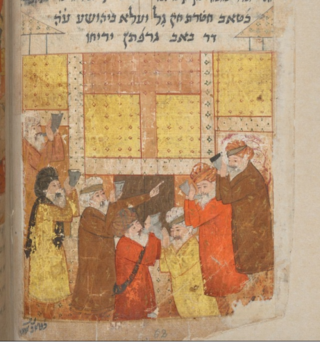
Judeo-Persian refers to both a group of Jewish dialects spoken by the Jews living in Iran and Judeo-Persian texts. As a collective term, Judeo-Persian refers to a number of Judeo-Iranian languages spoken by Jewish communities throughout the formerly extensive Persian Empire, including the Mountain and Bukharan Jewish communities.

Jewish languages are the various languages and dialects that developed in Jewish communities in the diaspora. The original Jewish language is Hebrew, supplanted as the primary vernacular by Aramaic following the Babylonian exile. Jewish languages feature a syncretism of Hebrew and Judeo-Aramaic with the languages of the local non-Jewish population.

Judeo-Arabic dialects are ethnolects formerly spoken by Jews throughout the Arab world. Under the ISO 639 international standard for language codes, Judeo-Arabic is classified as a macrolanguage under the code jrb, encompassing four languages: Judeo-Moroccan Arabic (aju), Judeo-Yemeni Arabic (jye), Judeo-Egyptian Arabic (yhd), and Judeo-Tripolitanian Arabic (yud).

Luri is a Southwestern Iranian language continuum spoken by the Lurs, an Iranian people native to Western Asia. The Luri dialects are descended from Middle Persian and are Central Luri, Bakhtiari, and Southern Luri. This language is spoken mainly by the Bakhtiari and Southern Lurs in Iran.

The Jewish Neo-Aramaic dialect of Zakho is a dialect of Northeastern Neo-Aramaic originally spoken by Jews in Zakho, Iraq. Following the exodus of Jews from the Muslim lands, most speakers now live in Israel, principally Jerusalem and surrounding villages.

The Jewish Neo-Aramaic dialect of Urmia, a dialect of Northeastern Neo-Aramaic, was originally spoken by Jews in Urmia and surrounding areas of Iranian Azerbaijan from Salmas to Solduz and into what is now Yüksekova, Hakkâri and Başkale, Van Province in eastern Turkey. Most speakers now live in Israel.
Trans-Zab Jewish Neo-Aramaic, also known as Hulaulá, is a grouping of related dialects of Northeastern Neo-Aramaic originally spoken by Jews in Iranian Kurdistan and easternmost Iraqi Kurdistan. Most speakers now live in Israel.
Barzani Jewish Neo-Aramaic is a modern Jewish Aramaic language, often called Neo-Aramaic or Judeo-Aramaic. It was originally spoken in three villages near Aqrah in Iraqi Kurdistan. The native name of the language is Lishanid Janan, which means 'our language', and is similar to names used by other Jewish Neo-Aramaic dialects .

Judaeo-Aramaic languages represent a group of Hebrew-influenced Aramaic and Neo-Aramaic languages.

Judeo-Tat or Juhuri is a Judeo-Persian dialect of the Tat language historically spoken by the Mountain Jews, primarily in Azerbaijan, Dagestan, and today in Israel. It belongs to the southwestern group of the Iranian division of the Indo-European languages with heavy influence from the Hebrew language. In the era of Soviet historiography, the Mountain Jews were mistakenly considered to be related to the Muslim Tats of Azerbaijan. However, they do not share a common linguistic heritage, as the Mountain Jews kept their native language, while the Muslim Tats eventually adopted Persian. The words Juvuri and Juvuro translate as "Jewish" and "Jews".
Judeo-Hamadani and Judeo-Borujerdi constitute a Northwestern Iranian language, originally spoken by the Iranian Jews of Hamadan and Borujerd in western Iran. Hamadanis refer to their language as ebri "Hebrew" or zabān-e qadim "old language". Though not Hebrew, the term ebri is used to distinguish Judeo-Hamadani from Persian.
In 1920, Hamadan had around 13,000 Jewish residents. According to members of the community that Donald Stilo encountered in 2001-02, there were only eight people from the Jewish community left in Hamadān at the time, but others can still be found in Israel, New York City, and most predominantly in Los Angeles.
Judaeo-Romance languages are Jewish languages derived from Romance languages, spoken by various Jewish communities originating in regions where Romance languages predominate, and altered to such an extent to gain recognition as languages in their own right. The status of many Judaeo-Romance languages is controversial as, despite manuscripts preserving transcriptions of Romance languages using the Hebrew alphabet, there is often little-to-no evidence that these "dialects" were actually spoken by Jews living in the various European nations.
Judeo-Shirazi is a variety of Fars. Some Judeo-Shirazi speakers refer to the language as Jidi, though Jidi is normally a designation used by speakers of Judeo-Esfahani. It is spoken mostly by Persian Jews living in Shiraz and surrounding areas of the Fars Province in Iran.

The Western Iranian languages or Western Iranic languages are a branch of the Iranian languages, attested from the time of Old Persian and Median.
Northeastern Neo-Aramaic (NENA) is a grouping of related dialects of Neo-Aramaic spoken before World War I as a vernacular language by Jews and Assyrian Christians between the Tigris and Lake Urmia, stretching north to Lake Van and southwards to Mosul and Kirkuk. As a result of the Assyrian genocide, Christian speakers were forced out of the area that is now Turkey and in the early 1950s most Jewish speakers moved to Israel. The Kurdish-Turkish conflict resulted in further dislocations of speaker populations. As of the 1990s, the NENA group had an estimated number of fluent speakers among the Assyrians just below 500,000, spread throughout the Middle East and the Assyrian diaspora. In 2007, linguist Geoffrey Khan wrote that many dialects were nearing extinction with fluent speakers difficult to find.
Baghdad Jewish Arabic or autonymhaki mal yihud or el-haki malna is the variety of Arabic spoken by the Jews of Baghdad and other towns of Lower Mesopotamia in Iraq. This dialect differs from the North Mesopotamian Arabic spoken by Jews in Upper Mesopotamian cities such as Mosul and Anah. Baghdadi and Northern Mesopotamian are subvarieties of Judeo-Iraqi Arabic.

Judaeo-Spanish or Judeo-Spanish, also known as Ladino, is a Romance language derived from Old Spanish.
Soi (Sohi) is one of the Central Iranian language varieties of Iran, one of five listed in Ethnologue that together have 35,000 speakers. It is closely related to Natanzi.
Judeo-Kashani ("Kashi") is a subvariety of Judeo-Iranian spoken by the Jews of Kashan (Kāšān). Diachronically, Judeo-Kashani is a Median language, belonging to the Kashanic branch of the Central Plateau Language Group spoken across Central Iran.









